Cottonmouth
Agkistrodon piscivorus
The cottonmouth (also known as a water moccasin) is a highly venomous pit viper that spends most of its life near water.
Advertisement
Cottonmouth Scientific Classification
- Kingdom
- Animalia
- Phylum
- Chordata
- Class
- Reptilia
- Order
- Squamata
- Family
- Viperidae
- Genus
- Agkistrodon
- Scientific Name
- Agkistrodon piscivorus
Read our Complete Guide to Classification of Animals.
Cottonmouth Conservation Status
Cottonmouth Facts
- Prey
- Fish, rodents, shrews, frogs, reptiles, birds, insects, and eggs
- Fun Fact
- The cottonmouth (also known as a water moccasin) is a highly venomous pit viper that spends most of its life near water.
- Litter Size
- Up to 16 live young
View all of the Cottonmouth images!
The cottonmouth snake (also known as a water moccasin) is a highly venomous pit viper that spends most of its life near the water.
Cottonmouths are considered to be one of the few semi-aquatic snakes in the world. They can sometimes be seen swimming in both freshwater and saltwater areas. There are generally two species: the northern cottonmouth snake and the Florida cottonmouth.
This article will cover some interesting facts about the identification, habitat, diet, lifespan, and size of both species.
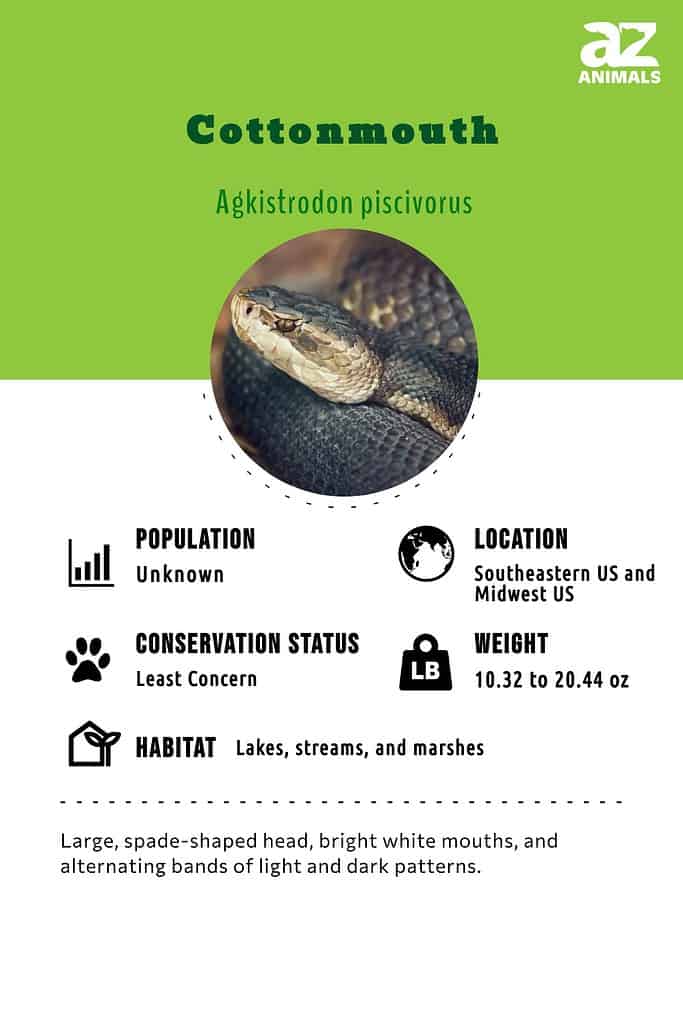
What’s the difference between a cottonmouth snake vs. a water moccasin?
There is no difference. They are simply two different names for the exact same species.
5 Cottonmouth Amazing Facts
- The cottonmouth goes by many different names, including water moccasin, swamp moccasin, rusty moccasin, and black moccasin. A moccasin is essentially a type of shoe or slipper made from leather.
- The cottonmouth snake can choose to mate at any time throughout the entire year, but its reproductive season usually takes place in April and May. In order to attract a mate, the male cottonmouth will perform a combat dance in which he slithers back and forth and waves his tail. Males will also fight each other for access to females. Cottonmouths are thought to be monogamous.
- Females will give birth to an average of five to nine live young at a time (16 is usually the maximum number) after a gestation period of five months. However, because of predators, only two or three young will usually make it to adulthood. It takes about three years for a female to reach full sexual maturity (the sexual maturity of the male is unknown). If they survive, then they have a typical lifespan of 20 to 25 years.
- The predators of juvenile or baby cottonmouth snakes include eagles, egrets, raccoons, longnose gars, largemouth bass, and snapping turtles. Adult cottonmouths, by contrast, have very few predators.
- Female cottonmouth snakes are capable of both sexual and asexual reproduction. This means they can produce young in the absence of males (although at the cost of genetic diversity).
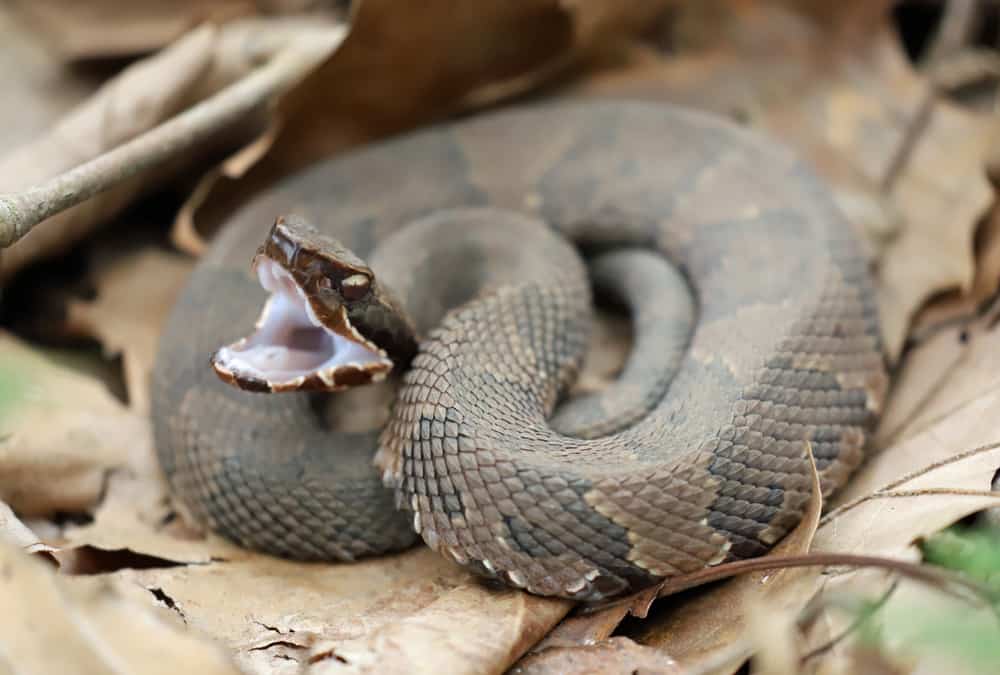
The cottonmouth goes by many different names, including water moccasin, swamp moccasin, rusty moccasin, and black moccasin.
©KF2017/Shutterstock.com
Where to Find Them
Cottonmouths can be found all year round in many aquatic locations, including cypress swamps, river floodplains, lakes, bays, and wetlands, throughout the southeastern United States.
Their range extends all the way up to southern Illinois and west to Texas; there is also a bit of overlap in Florida between the northern cottonmouth and the Florida cottonmouth.
They like to spend their days basking near logs, rocks, and branches close to the location of the water’s edge. The size of the cottonmouth snake’s territory depends on its physical size and sex (males tend to have larger home ranges).
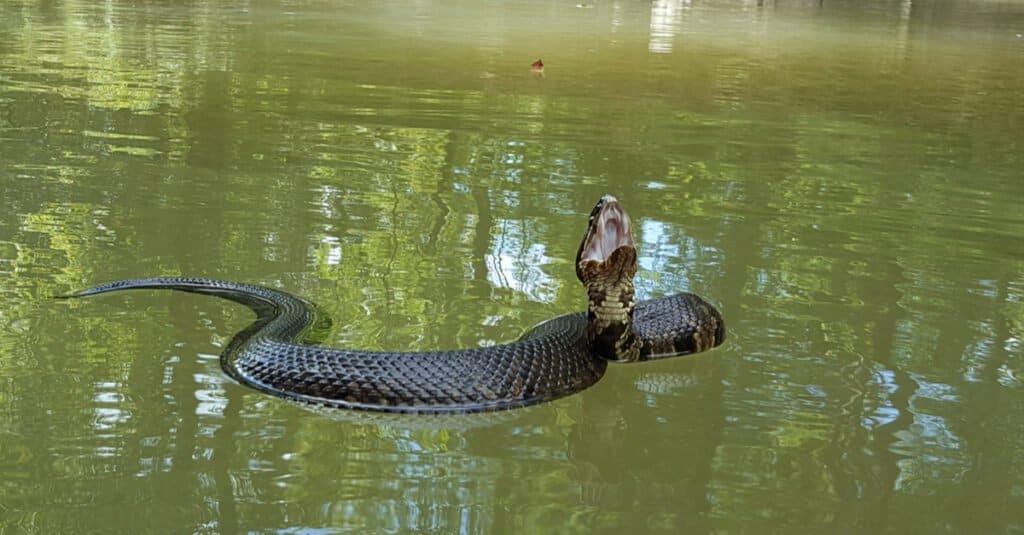
Throughout the southeastern United States, cottonmouths can be found all year round in many aquatic locations, including cypress swamps, river floodplains, lakes, bays, and wetlands.
©Seth LaGrange/Shutterstock.com
Scientific Name
The scientific name of the northern cottonmouth is Agkistrodon piscivorus, whereas the Florida cottonmouth is called Agkistrodon conanti. The genus name Agkistrodon essentially means hook tooth (or a tooth like a fishhook) in reference to the shape of the fangs.
The species name piscivorus essentially means fish devourer or fish eater, whereas conanti is named in honor of noted herpetologist Roger Conant.
The northern vs. Florida cottonmouth distinction only came about in 2015. Before then, there used to be three subspecies recognized: the eastern, western, and Florida cottonmouths. However, based on DNA analysis, it was determined to make the Florida cottonmouth snake its own species and eliminate the eastern/western distinction entirely.
That leaves us with two species, the Florida and northern cottonmouths, and no subspecies. Both of these species are closely related to copperheads and the cantils in the same genus of Agkistrodon.
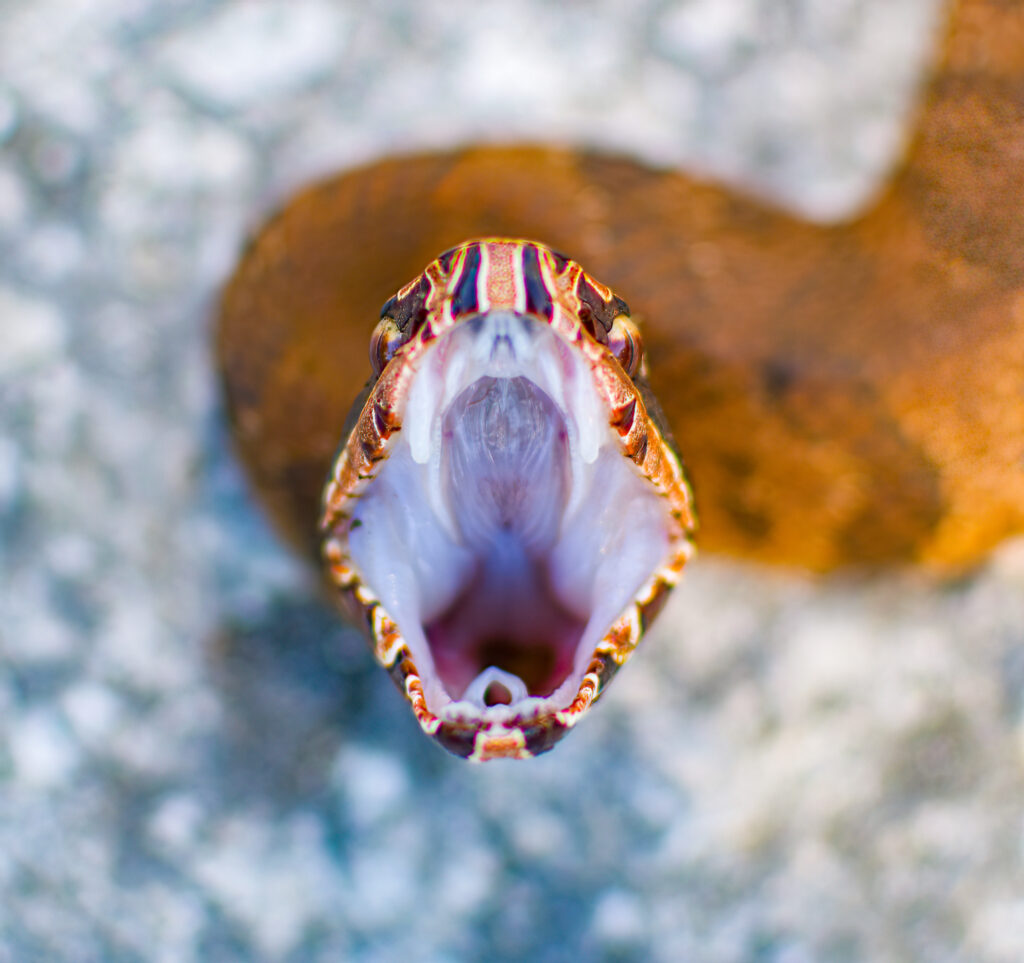
The scientific name of the northern cottonmouth is Agkistrodon piscivorus, whereas the Florida cottonmouth is called Agkistrodon conanti.
©iStock.com/Chase D’animulls
Types of Cottonmouth
There are two main varieties of cottonmouths. The differences between them in terms of appearance and habits are minimal; however, Northern Cottonmouths have darker scales.
- Northern Cottonmouth – Eastern Cottonmouths can be found in the southeast United States.
- Florida Cottonmouth – Florida Cottonmouths are found in the midwest United States.
History and Evolution
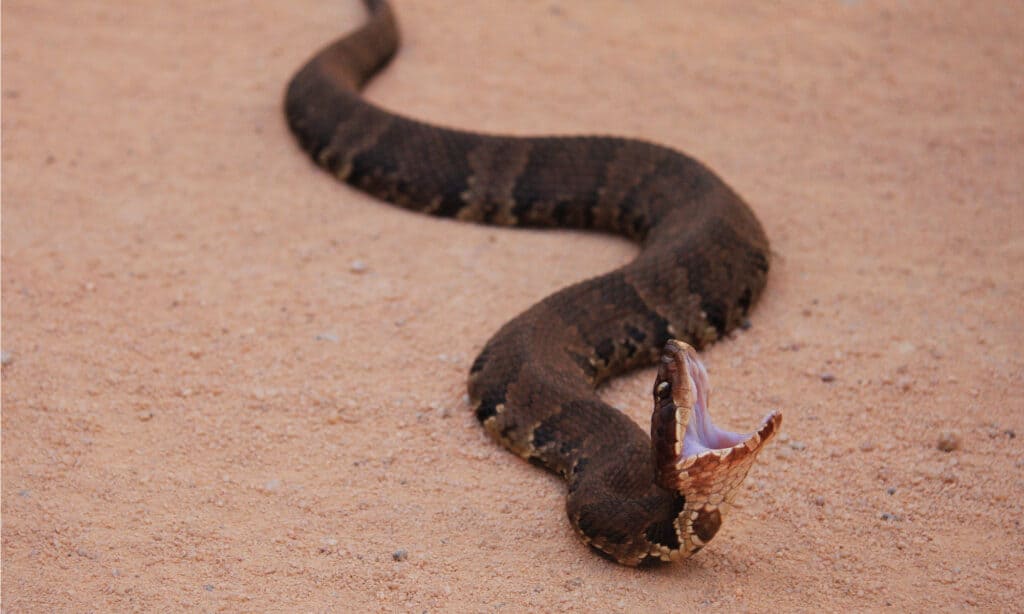
Cottonmouth crossing a dirt road showing mouth, Agkistrodon piscivorus
©Nathan A Shepard/Shutterstock.com
The Cottonmouth is well-known in the United States for its powerful venom and, most notably, the stark white inside of its mouth. That is where this snake got its name to match the color of cotton.
These reptiles also stand out from other aquatic snakes by the way they swim through water. Cottonmouths glide on top of rivers and lakes with their heads held high as they cruise along. While they tend to keep their head above water, they have evolved the ability to strike while underwater.
Another evolution of this snake is its hemotoxic venom. This type of venom prevents clotting from a wound from a Cottonmouth’s bite, and it also destroys its victim’s red blood cells.
A myth about these snakes, which is not to be believed, is that one could fall into a pit of Cottonmouths and suffer deadly attacks. One may recall this happening to a cowboy in the Lonesome Dove miniseries. This is a falsity because these snakes are actually solitary in nature.
Population and Conservation Status
According to the IUCN Red List, the snake is a species of least concern. While we don’t have enough facts about population numbers to make a proper estimate, this species does appear to be fairly common throughout most of its natural range. However, the loss of wetlands habitats throughout the southern United States does pose a danger to certain cottonmouth populations.
How to Identify Them: Appearance and Description
The adult can reach anywhere between 2 feet and 6 feet long with the largest cottonmouth ever recorded measuring 74 inches in length.
Males are typically longer and heavier, with more scales on the tail than their female counterparts. This should make the identification of the sexes easier. The cottonmouth snake is characterized by a large, spade-shaped head, bright white mouths, and alternating bands of light and dark patterns.
Black, brown, and olive are the most common colors; they help the snake blend in against the surrounding environment. Juveniles and babies are also fairly distinctive from adults. They have even stronger contrasting bands of colors; the tip of the tail is sometimes yellow or greenish as well.
How to identify the snake:
- Large spade-shaped head.
- Long, thick, muscular body measuring up to 6 feet in size.
- Black, brown, and olive colors alternating in light and dark bands.
- Bright white mouths.
You can read further about the types of cottonmouth snakes.
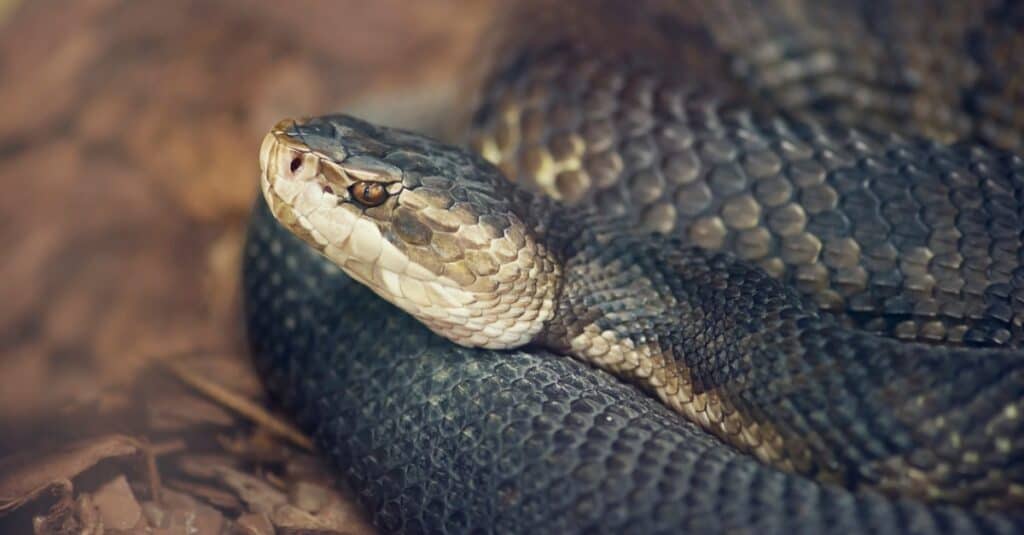
©iStock.com/Saddako
How Dangerous Are They?
These snakes have highly potent venom that destroys the tissue and causes significant swelling and pain. It is generally more dangerous than the copperhead venom but less so than the rattlesnake. The venom will sometimes leave behind permanent scars and very rarely necessitates an amputation, but it is almost never fatal even in the absence of treatment.
Nevertheless, you should still seek medical attention immediately after a bite. The antivenom is highly effective at minimizing the effects of the toxin.
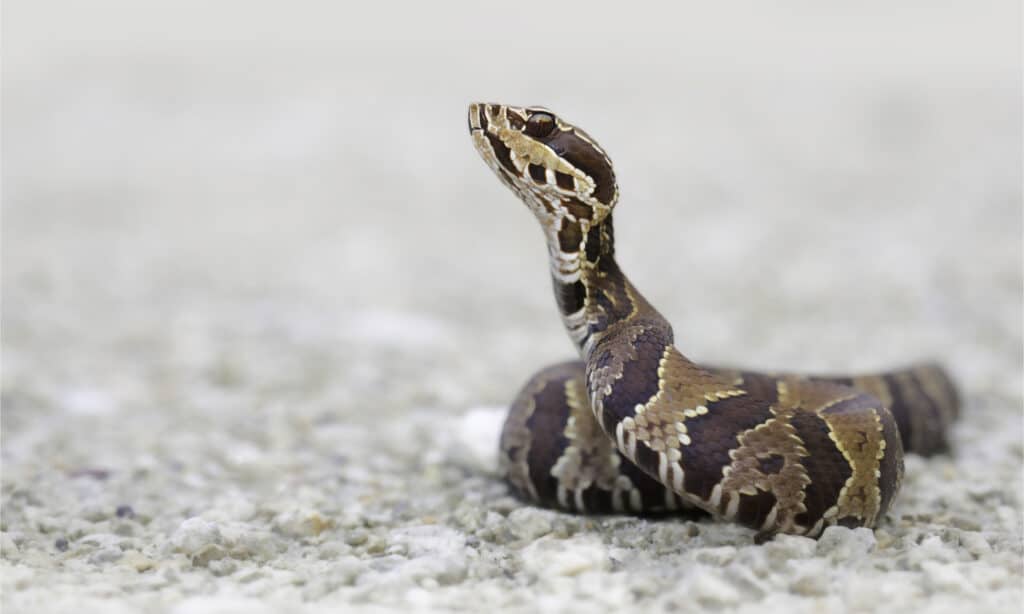
The cottonmouth is generally more dangerous than the copperhead but less so than the rattlesnake.
©Kristian Bell/Shutterstock.com
Behavior and Humans

Cottonmouth swimming in water. The snake has a long, thick, muscular body measuring up to 6 feet in size.
©Seth LaGrange/Shutterstock.com
Cottonmouths are widespread throughout the South, and encounters with them are fairly common. Although quite dangerous in theory, cottonmouths tend not to bite humans very often in practice. They would rather run away and flee.
Before striking, the snake will give a warning signal by shakings its tail, opening its mouth, and raising its head above the ground. Cottonmouth snakes also have the ability to release a pungent, foul-smelling musk to deter potential threats.
Even if one did happen to bite you, however, they deliberately release less venom in a defensive bite than an offensive one against their prey.
View all 235 animals that start with CCottonmouth FAQs (Frequently Asked Questions)
What snakes are cottonmouths mistaken for?
Cottonmouths are mistaken for many snakes, but a primary one is the northern water snake. Both snakes are aquatic and have similar coloration. However, the key difference between northern water snakes and cottonmouths is that cottonmouths are venomous while northern water snakes are not.
Cottonmouths are also sometimes confused for other water snakes like the yellow-bellied watersnake or the Florida banded watersnake. Once again, yellow-bellied watersnakes are not venomous while cottonmouths are.
What is the difference between cottonmouths and kingsnakes?
When separating kingsnakes vs. cottonmouths, the most important difference is that kingsnakes are nonvenomous while cottonmouths are venomous. In fact, kingsnakes are constrictors that often hunt venomous snakes!
How do cottonmouths compare to coachwhips?
Coachwhips are more slender and faster than cottonmouths. The primary difference to be aware of between coachwhips and cottonmouths is that coachwhips are nonvenomous while cottonmouths are venomous.
Are cottonmouths venomous?
Yes, the cottonmouth venom is quite dangerous. While they do tend to hold back against people by injecting only a partial dose, the venom can still do serious damage, especially if left untreated. People often make a mistake in terminology by calling this snake poisonous. In fact, a venomous animal creates and then injects its own toxins, whereas poisonous animals are toxic to eat. Therefore, very few snakes are truly poisonous.
How do cottonmouths hunt?
Cottonmouths have multiple ways to find and identify prey. They often make use of their developed hearing and vision. They can also sense smells by flicking the tongue into the air and then pressing the scent molecules against a sensory organ on the roof of the mouth (they smell with the nose too, but it’s not as effective). Once they’ve made a proper identification, the cottonmouths will bite the prey and release the venom into its body. The prey will be held in the coils until it is dead. The cottonmouth has the ability to detach its jawbone to swallow the prey whole.
Are cottonmouths aggressive?
These reptiles can be quite aggressive if they are cornered or provoked in some manner. For this reason, they should not be approached in the wild. However, most of these snakes would rather run away and flee than stand their ground and strike.
Where do cottonmouths live?
These reptiles live near sources of water, including wetland habitats, lakes, rivers, and bays. Northern cottonmouths are found in various locations throughout the southeastern United States. The range of the Florida cottonmouth, as the name suggests, is mostly restricted to that state.
What do cottonmouths eat?
The diet largely consists of fish, rodents, and other small mammals. They will also sometimes consume birds, frogs, turtles, eggs, insects, and other snakes. Baby cottonmouths are basically born ready to hunt and feed on smaller animals.
Why is it called cottonmouth?
They are called cottonmouths because of the bright white coloration inside of the mouths, which they show off when threatened. Water moccasin is another accepted name.
What's the difference between a cottonmouth and a rattlesnake?
The main differences between a cottonmouth and a rattlesnake are their preferred habitats and physical appearances. Cottonmouths have white mouths, and rattlesnakes have rattles on the ends of their tails.
What are the differences between brown water snakes and cottonmouths?
The differences between brown water snakes and cottonmouths are their appearance, preferred habitat, behavior, diet, and relative danger.
How do cottonmouths compare to timber rattlesnakes?
Both cottonmouths and timber rattlesnakes have territory that overlaps, but they prefer different habitats. While cottonmouth snakes enjoy aquatic areas, timber rattlesnakes are normally found in forested areas. The bite of the timber rattlesnake is generally considered more serious, although bites from both snakes demand medical attention.
What's the difference between a black racer and a cottonmouth?
When comparing a black racer vs. a cottonmouth snake, while they both can share similar habitats throughout the southeast of America, the two snakes look very different. Most importantly, black racers are non-venomous while cottonmouths have venom.
Can cottonmouths breed with copperheads?
Because the two species are in the same genus (Agkistrodon), interbreeding is possible.
Is a cottonmouth more venomous than a coral snake?
No. A coral snake is more venomous than a cottonmouth snake.
What are the differences between hognose snakes and cottonmouths?
The key difference between the cottonmouth and hognose snake is that the cottonmouth is highly venomous, whereas the hognose snake is only dangerous to toads.
Check out other differences here!
Which is more venomous between a black mamba and a cottonmouth?
Black mambas are deadlier and more venomous than cottonmouths.
What are the differences between a cobra and a cottonmouth?
The main differences between a cottonmouth and a cobra are their size, venom, and distribution.
Thank you for reading! Have some feedback for us? Contact the AZ Animals editorial team.
Sources
- University of Georgia, Available here: https://srelherp.uga.edu/snakes/agkpis.htm
- Animal Diversity Web, Available here: https://animaldiversity.org/accounts/Agkistrodon_piscivorus/

















